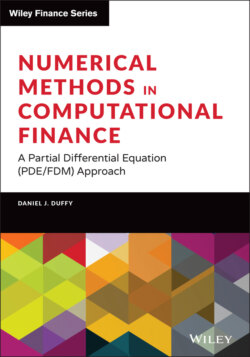Читать книгу Numerical Methods in Computational Finance - Daniel J. Duffy - Страница 40
2.3.2 Discrete Maximum Principle
ОглавлениеHaving developed some difference schemes, we would like to have a way of determining if the discrete solution is a good approximation to the exact solution in some sense. Although we do not deal with this issue in great detail, we do look at stability and convergence issues.
Definition 2.1 The one-step difference scheme of the form (2.13) is said to be positive if:
(2.17)
implies that . Here, is a mesh function defined at the mesh points .
Based on this definition, we see that the implicit Euler scheme is always positive while the explicit Euler scheme is positive if the term:
is positive. Thus, if the function achieves large values (and this happens in practice), we will have to make very small in order to produce good results. Even worse, if does not satisfy the constraint in (2.18) then the discrete solution looks nothing like the exact solution, and so-called spurious oscillations occur. This phenomenon occurs in other finite difference schemes, and we propose a number of remedies later in this book.
Definition 2.2 A difference scheme is stable if its solution is based in much the same way as the solution of the continuous problem (2.1) (see Theorem 2.1), that is:
(2.19)
where:
and:
Based on the fact that a scheme is stable and consistent (see Dahlquist and Björck (1974)), we can state in general that the error between the exact and discrete solutions is bounded by some polynomial power of the step-size :
(2.20)
where is a constant that is independent of . For example, in the case of schemes (2.10), (2.11) and (2.12) we have:
(2.21)
Thus, we see that the Box method is second-order accurate and is better than the implicit Euler scheme, which is only first-order accurate.
